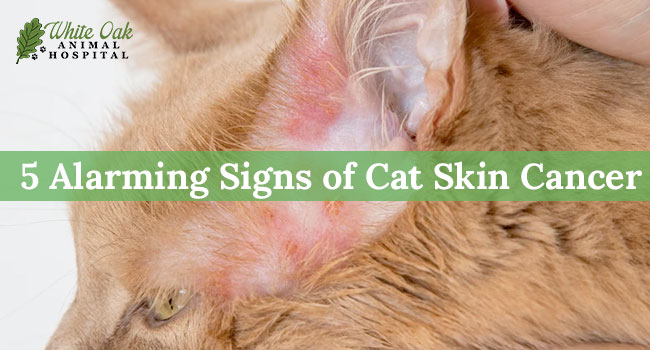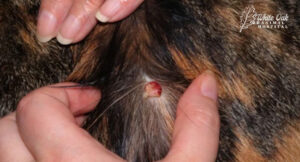
The importance of early detection in managing cat skin cancer cannot be overstated. As pet owners, being vigilant about our feline friends’ health is paramount, especially when it comes to skin cancer—a condition that, while treatable, poses significant risks. Understanding the dangers of cat skin cancer is crucial in safeguarding the health and well-being of our cats.
 This condition, often resulting from factors like sun exposure, especially in cats with light or thin fur, requires our attention and proactive care. We can take timely action by recognizing symptoms such as sunburn, which manifests as red skin or hair loss, mainly in less pigmented areas.
This condition, often resulting from factors like sun exposure, especially in cats with light or thin fur, requires our attention and proactive care. We can take timely action by recognizing symptoms such as sunburn, which manifests as red skin or hair loss, mainly in less pigmented areas.
Furthermore, understanding the types of skin cancer that can affect cats, such as malignant melanoma, squamous cell carcinoma, and mast cell tumors, and knowing their causes, symptoms, and treatment options are essential for effective management and care.
Common Types of Cat Skin Cancer
Cat skin cancer encompasses various forms, each distinct in appearance, progression, and severity. Understanding these types is essential for early detection and effective treatment. Awareness of these common types of cat skin cancer can guide pet owners in monitoring their cats for early signs, facilitating prompt veterinary consultation and intervention.
Malignant Melanoma
This cancer develops in the melanocytes, the pigment-producing cells of the skin. Though primarily found in mucous membranes, it can occasionally appear on fur-covered skin. Malignant melanoma is aggressive and can rapidly spread to lymph nodes and other organs. Its link to UV exposure is less evident in cats than in humans, but genetics may play a significant role.
Squamous Cell Carcinoma
 Often sun-induced, this cancer starts as solar dermatitis, characterized by red, crusty areas, commonly on ear tips. Initially mistaken for minor abrasions, these can progress to cancer, requiring surgery or specialized therapies like radiation. This cancer type, which can also affect the face, rarely spreads to other body parts until later stages.
Often sun-induced, this cancer starts as solar dermatitis, characterized by red, crusty areas, commonly on ear tips. Initially mistaken for minor abrasions, these can progress to cancer, requiring surgery or specialized therapies like radiation. This cancer type, which can also affect the face, rarely spreads to other body parts until later stages.
Mast Cell Tumors
Found in the immune system’s mast cells, these manifest as lumps on or under the skin. Factors like genetics, inflammation, and irritation are linked to its development. Siamese cats are thought to be more susceptible to this cancer type.
5 Early Signs and Symptoms of Cat Skin Cancer
 Recognizing the early signs of cat skin cancer is essential for ensuring prompt and effective treatment. The first sign to watch for is the emergence of unusual skin lumps or bumps. These growths can vary in color – black, brown, grey, pink, or red – and Dr. Damron should examine any new or changing lumps.
Recognizing the early signs of cat skin cancer is essential for ensuring prompt and effective treatment. The first sign to watch for is the emergence of unusual skin lumps or bumps. These growths can vary in color – black, brown, grey, pink, or red – and Dr. Damron should examine any new or changing lumps.
Another critical sign is the presence of persistent sores or lesions. These sores might initially appear insignificant, but their refusal to heal over time could indicate skin cancer. It’s important not to dismiss them as mere scratches or abrasions.
Changes in the skin’s pigmentation or texture also serve as a warning. This includes areas that become rougher, thicker, or undergo color changes. These alterations can be subtle, so a detailed and regular examination of your cat’s skin is recommended.
Sunburn-like symptoms are telling in cats, especially in areas with light pigmentation or sparse fur. Red skin or hair loss in these areas can precede the development of skin cancer, underscoring the need for protection against excessive sun exposure.
Finally, behavioral changes in cats, such as increased licking, scratching, or biting of specific skin areas, can indicate discomfort or irritation caused by an underlying issue like skin cancer. This behavioral change is often a cat’s way of responding to an abnormal or bothersome area.
As a pet owner, staying alert to these signs and seeking veterinary consultation at the earliest hint of these symptoms can significantly improve the chances of successful treatment. Regular check-ups, careful monitoring of skin changes, and protective measures against sun exposure are vital steps in safeguarding the health of our beloved feline companions against cat skin cancer.
Diagnostic Procedures for Cat Skin Cancer
 In diagnosing cat skin cancer, we primarily use biopsies and imaging techniques. A biopsy involves taking a small sample of the affected tissue for microscopic examination. This procedure is essential for determining whether a skin lesion is cancerous. In these cases, the most common type of biopsy is a fine needle aspiration, where a thin needle is used to extract cells from the tumor. Alternatively, a more comprehensive surgical biopsy might be necessary in certain situations.
In diagnosing cat skin cancer, we primarily use biopsies and imaging techniques. A biopsy involves taking a small sample of the affected tissue for microscopic examination. This procedure is essential for determining whether a skin lesion is cancerous. In these cases, the most common type of biopsy is a fine needle aspiration, where a thin needle is used to extract cells from the tumor. Alternatively, a more comprehensive surgical biopsy might be necessary in certain situations.
Imaging techniques such as X-rays or ultrasounds may also be employed, mainly if there’s a suspicion that the cancer has spread to other areas of the body. These methods provide a clearer picture of the cat’s internal state, helping assess the extent of the disease and guiding treatment decisions.
Together, these diagnostic tools form the cornerstone of identifying and evaluating cat skin cancer, guiding veterinarians toward the most effective treatment plan for each case.
Treatment Options for Cat Skin Cancer
 Treatment for cat skin cancer varies, depending on the type and stage. Surgery is a common approach, often involving the removal of the cancerous tissue. In more advanced cases, or when surgery isn’t feasible, chemotherapy and radiation therapy are considered. These methods aim to destroy cancer cells but can also affect healthy cells, leading to side effects.
Treatment for cat skin cancer varies, depending on the type and stage. Surgery is a common approach, often involving the removal of the cancerous tissue. In more advanced cases, or when surgery isn’t feasible, chemotherapy and radiation therapy are considered. These methods aim to destroy cancer cells but can also affect healthy cells, leading to side effects.
Emerging treatments in veterinary oncology are also gaining attention. Immunotherapy stimulates the immune system to fight cancer; targeted therapy, which focuses on specific molecular targets of cancer cells, is a promising area. These novel approaches might offer more precise treatment with fewer side effects than traditional methods.
Each treatment option has pros and cons, and the best course of action depends on the cat’s health, cancer type, and stage. Consulting with Dr. Damron, who is experienced in traditional and alternative cancer treatment, is crucial for a tailored treatment plan.
The Role of Pet Owners in Early Detection
 Pet owners play a vital role in the early detection of cat skin cancer. Regularly examining your cat for any changes in their skin or coat is critical. Look for signs such as unusual lumps, bumps, sores, or color changes, particularly in areas exposed to the sun. It’s also crucial to monitor for behavioral changes like excessive scratching or licking, which could indicate discomfort from an underlying issue.
Pet owners play a vital role in the early detection of cat skin cancer. Regularly examining your cat for any changes in their skin or coat is critical. Look for signs such as unusual lumps, bumps, sores, or color changes, particularly in areas exposed to the sun. It’s also crucial to monitor for behavioral changes like excessive scratching or licking, which could indicate discomfort from an underlying issue.
Scheduling regular veterinary check-ups is essential. Dr. Damron can spot early signs of skin cancer that might be overlooked. Ask us about the best schedule for these check-ups, especially for cats at higher risk due to factors like light fur or outdoor lifestyles.
Maintaining a healthy lifestyle for your cat is another proactive step. This includes ensuring a balanced diet, regular exercise, and minimizing sun exposure during peak hours. Sunscreens formulated for cats can be applied to exposed areas, especially for cats with light-colored fur.
By being observant and proactive, you can significantly increase the chances of early detection and successful treatment of cat skin cancer. Remember, your vigilance can make a life-saving difference for your feline companion.
 Early detection of cat skin cancer is a critical step in protecting and caring for our cats. At White Oak Animal Hospital, we understand the nuances of this condition and offer specialized care tailored to each feline patient. With over 28 years of experience and more than 6,000 pets treated, Dr. Casey Damron provides expert care that integrates traditional and innovative approaches.
Early detection of cat skin cancer is a critical step in protecting and caring for our cats. At White Oak Animal Hospital, we understand the nuances of this condition and offer specialized care tailored to each feline patient. With over 28 years of experience and more than 6,000 pets treated, Dr. Casey Damron provides expert care that integrates traditional and innovative approaches.
We also offer the convenience of TCVM Telemedicine consultations, ensuring your pet receives the best possible care, even from a distance. If you observe any signs of skin cancer in your cat, do not hesitate to contact White Oak Animal Hospital. Here, your cat will benefit from our comprehensive, integrative approach to treatment, making a significant difference in their health and wellbeing.
Frequently Asked Questions
What are the common signs of cat skin cancer?
Early signs of cat skin cancer include unusual skin lumps or bumps, persistent sores or lesions, skin pigmentation or texture changes, sunburn-like symptoms, especially in light-pigmented areas, and behavioral changes like increased licking or scratching of certain skin areas.
How can I protect my cat from sun-related skin cancer?
To protect your cat from sun-related skin cancer, managing their exposure to sunlight is essential, especially during peak UV hours from 10:00 am to 3:00 pm. You can do this by keeping them indoors during these times or ensuring they have access to ample shade if they are outside. Additionally, applying feline-specific sunscreen can provide extra protection, particularly on areas with less fur or lighter pigmentation, such as the ears and nose. This is a great option for hairless cats.
What are the treatment options for cat skin cancer?
Treatment options for cat skin cancer typically include surgery, chemotherapy, radiation therapy, and, in some cases, emerging treatments like immunotherapy or targeted therapy. The choice of treatment depends on the cancer type, stage, and overall health of the cat.
Related Posts
-
Eastern and Western Cat Cancer Treatments
As cats age, they often get lumps and bumps.In veterinary medicine, these are called masses…
-
What Are The Common Types Of Cat Cancer?
Cat cancer is an unfortunately common pet malady. Pets develop cancer for a variety of…
-
Most Effective Cat Allergy Remedies
Cat allergy remedies exist to treat a number of allergens. However, knowing the source of…
-
Best Cat Allergy Treatments For Your Pet
Once your veterinarian confirms your pet’s cat allergy diagnosis, work together on a treatment plan.…









